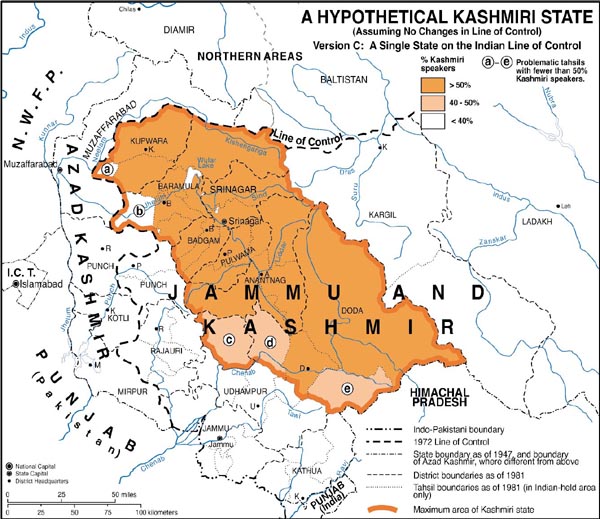A HYPOTHETICAL KASHMIRI STATE
With No Territorial Exchanges between India and Pakistan, Version C
If, for any reason, one or two sovereign Kashmiri states of the types discussed in the context of figure 6 (Versions A and B) cannot be constituted, it should still be possible to create a new Kashmiri state on the Indian side of the line only (Version C). We here include within its maximum potential area the whole of Kashmir proper as well as adjoining areas in which Kashmiri is either the majority language or that of a plurality of the population. Within this area are five problematic tahsils, lettered a-e on our map. In two of these, Karnah (a) and Uri (b), Kashmiri was recorded in 1981 as the mother tongue of 3.2% and 31.3% of the population respectively. But, given their geographic situation, both tahsils necessarily interact closely with the overwhelmingly Kashmiri-speaking area to their east; and it seems likely that a substantial proportion of their population would have a working knowledge of Kashmiri as a second language. One may, therefore, reasonably conclude that they would opt to join our hypothetical Kashmiri state. Of the three remaining tahsils, all of which have predominantly Muslim populations, Kashmiri-speakers accounted in 1981 for 44.1% of the population in Gool Gulab Garh (c), in Udhampur district; 41.2% in Ramban (d), in Doda district; and 42.3% in Bhadarwah (e), also in Doda district. In all three cases, speakers of disparate languages arbitrarily aggregated under the rubric "Hindi" exist in comparable or larger numbers; but, judging from censuses previous to that of 1981, no single tongue has as many speakers as Kashmiri. Thus, it seems rather likely that, given a choice, all three would opt to become part of a Kashmiri state.
In 1981, the population of the area of the hypothetical state of Kashmir, without the five problematic tahsils, was 3.28 million, of whom 90.1% were recorded as Kashmiri speakers. The comparable figures for the maximum area of the state came to 3.68 million and 84.4% respectively. The likely minimum and maximum area populations today would be approximately 5.2 million and 5.8 million respectively.
